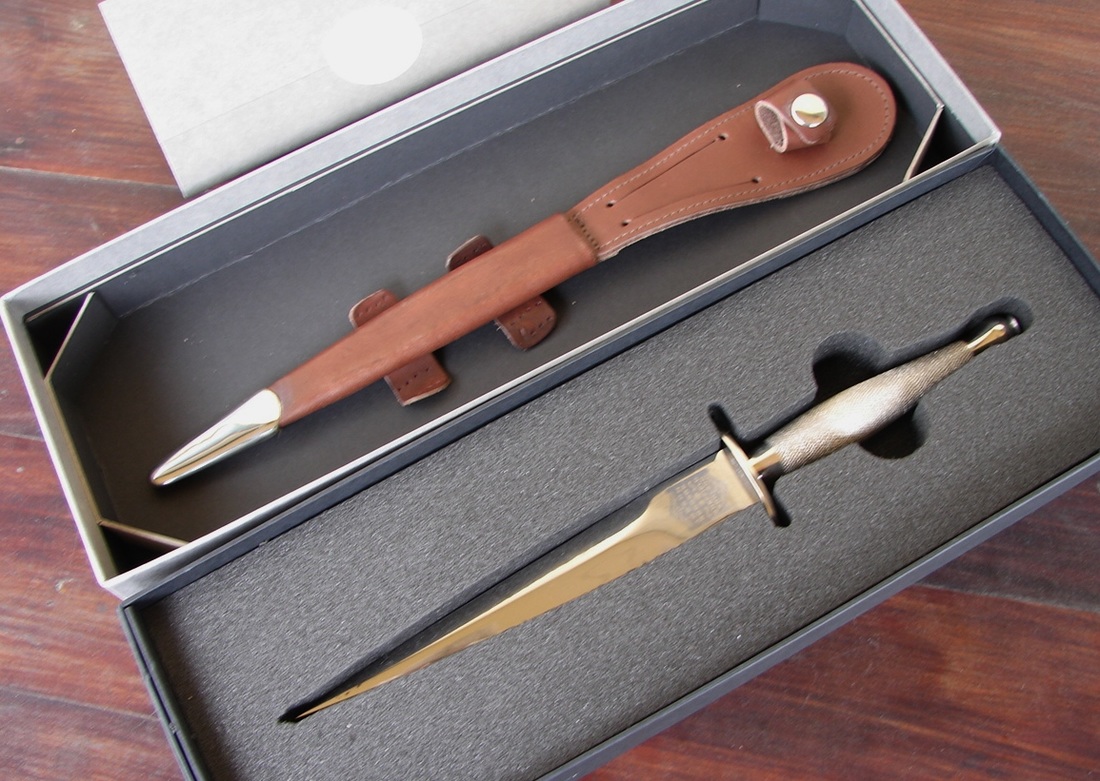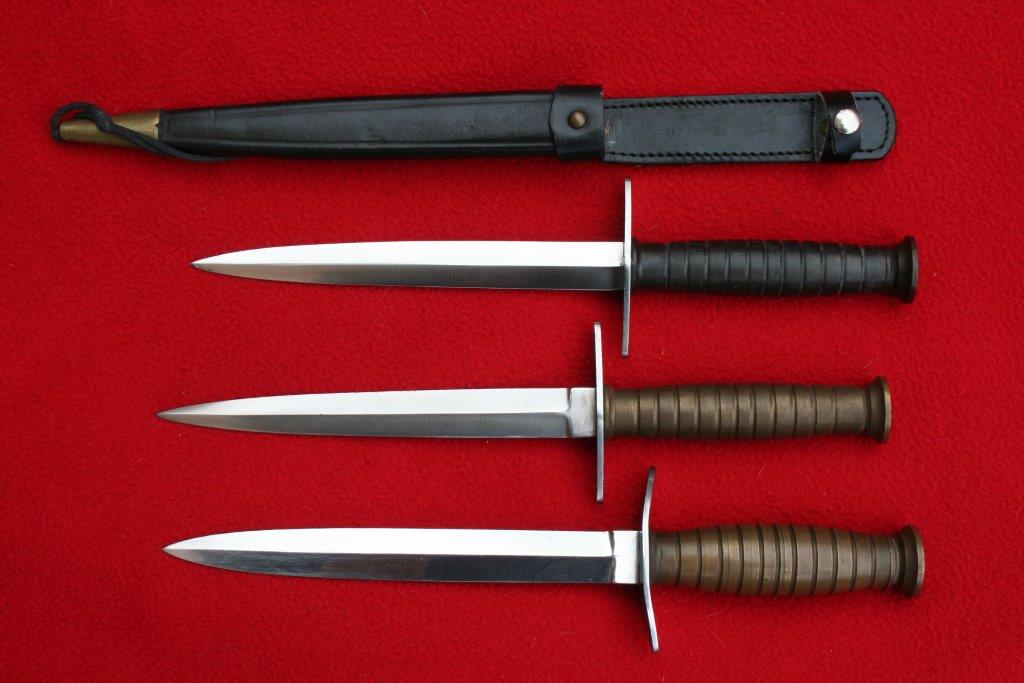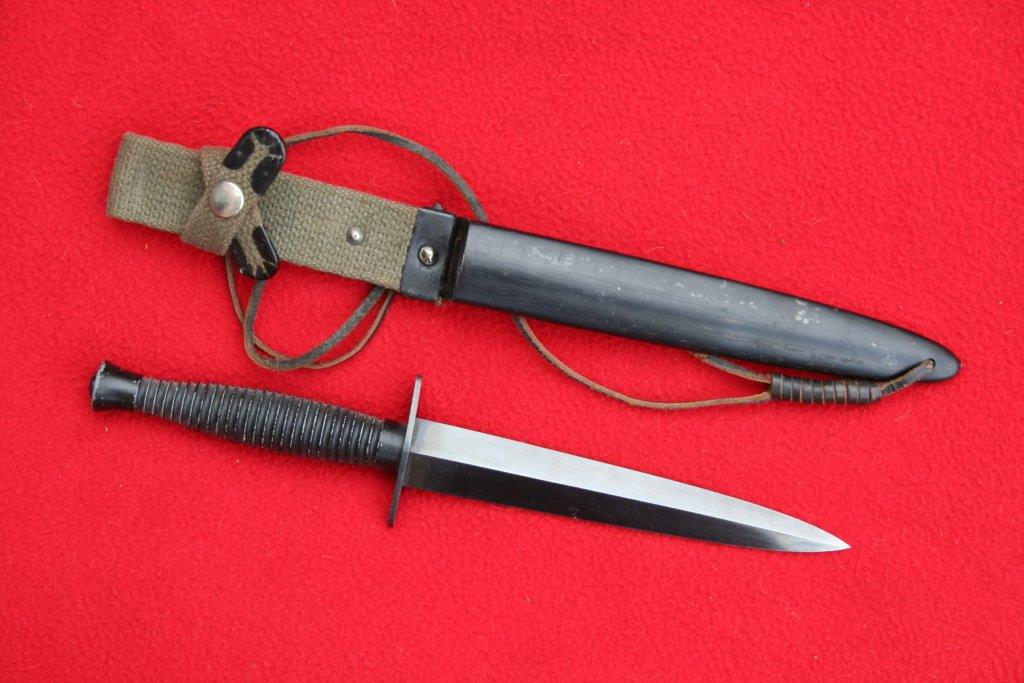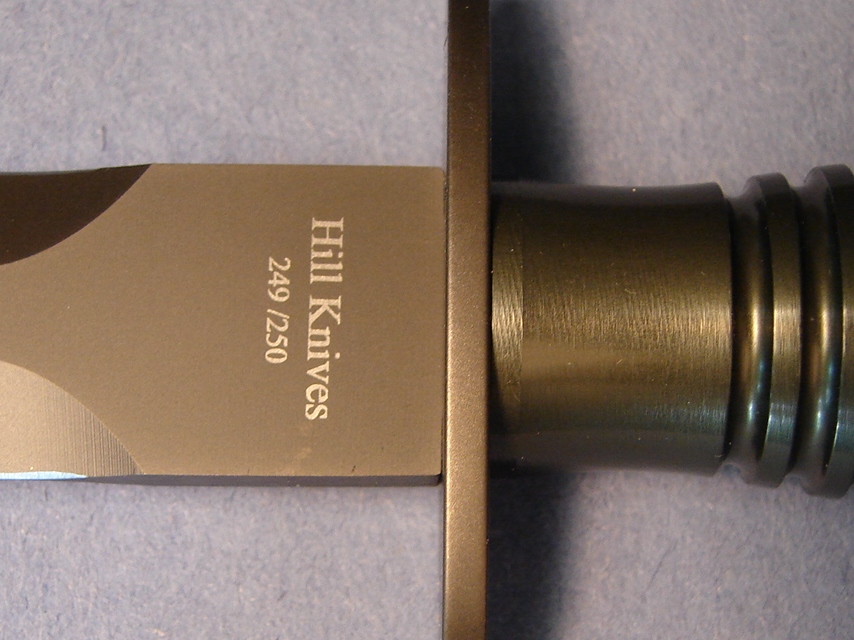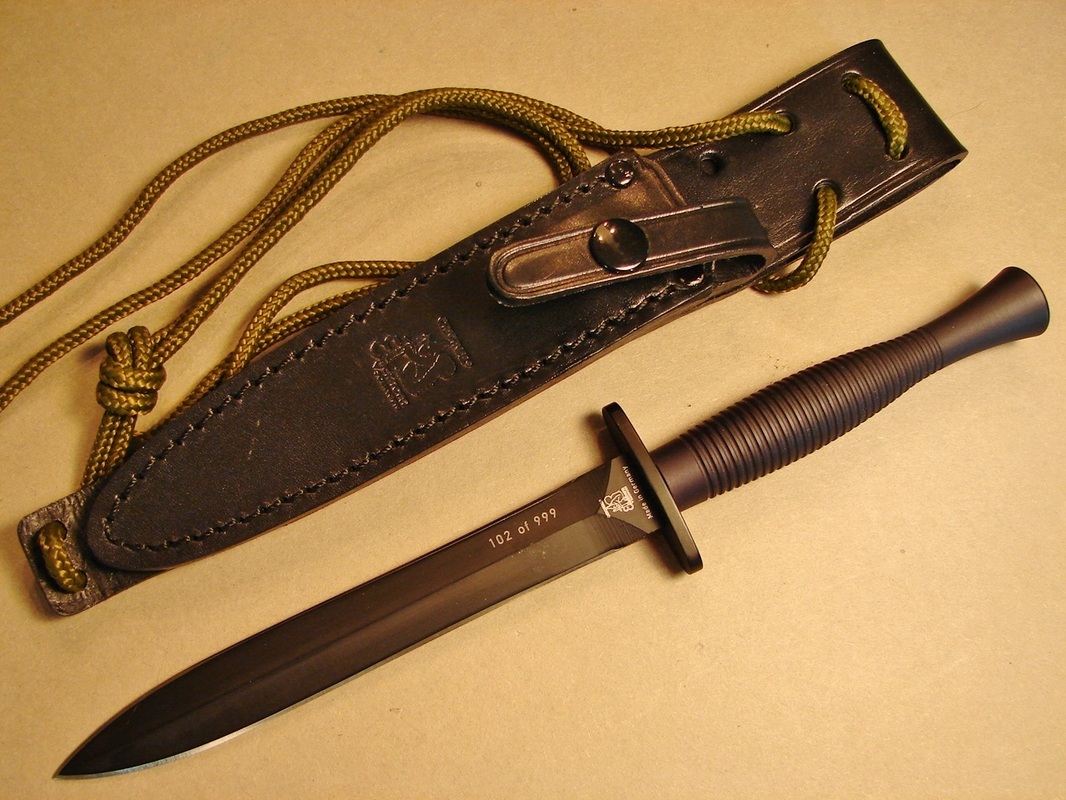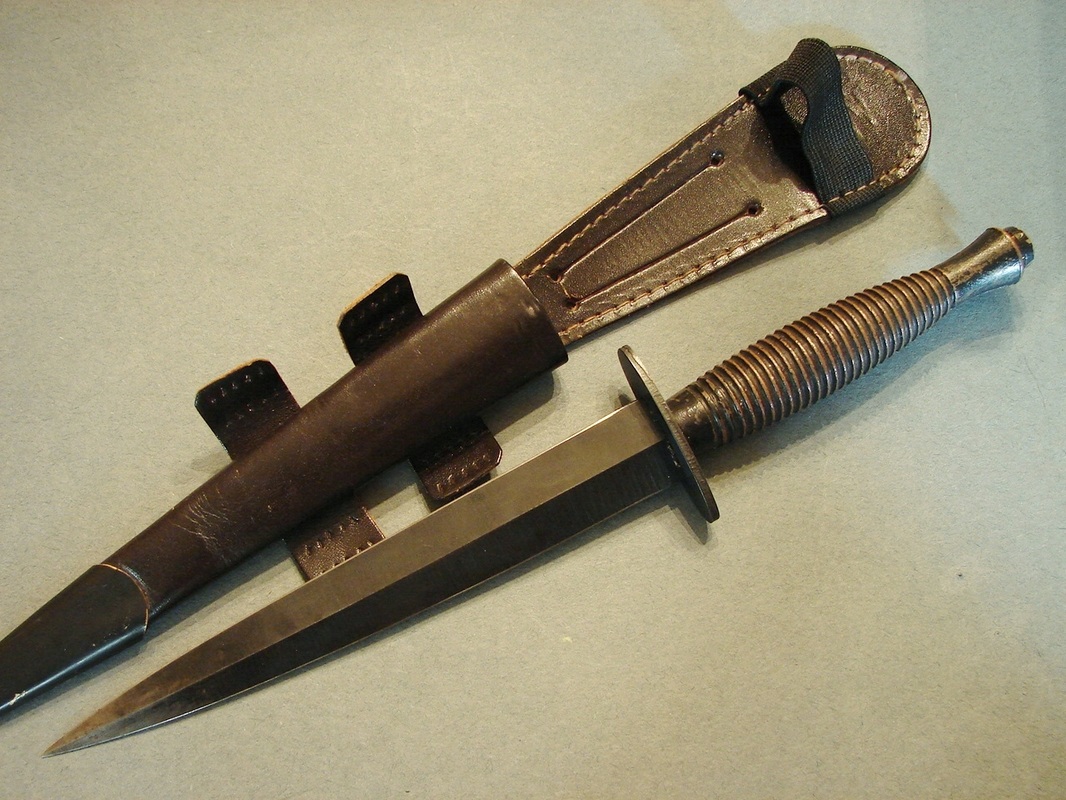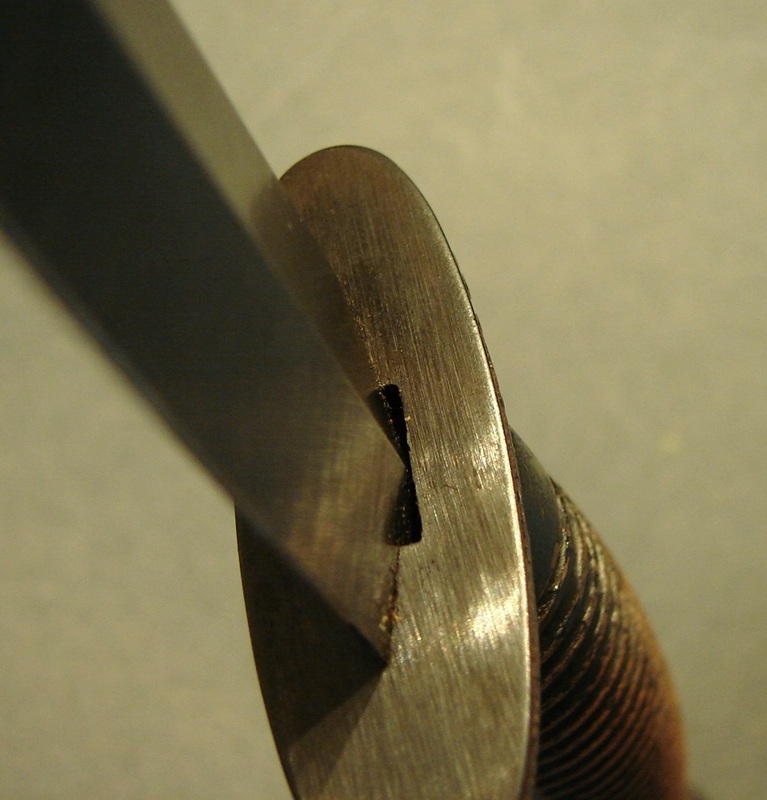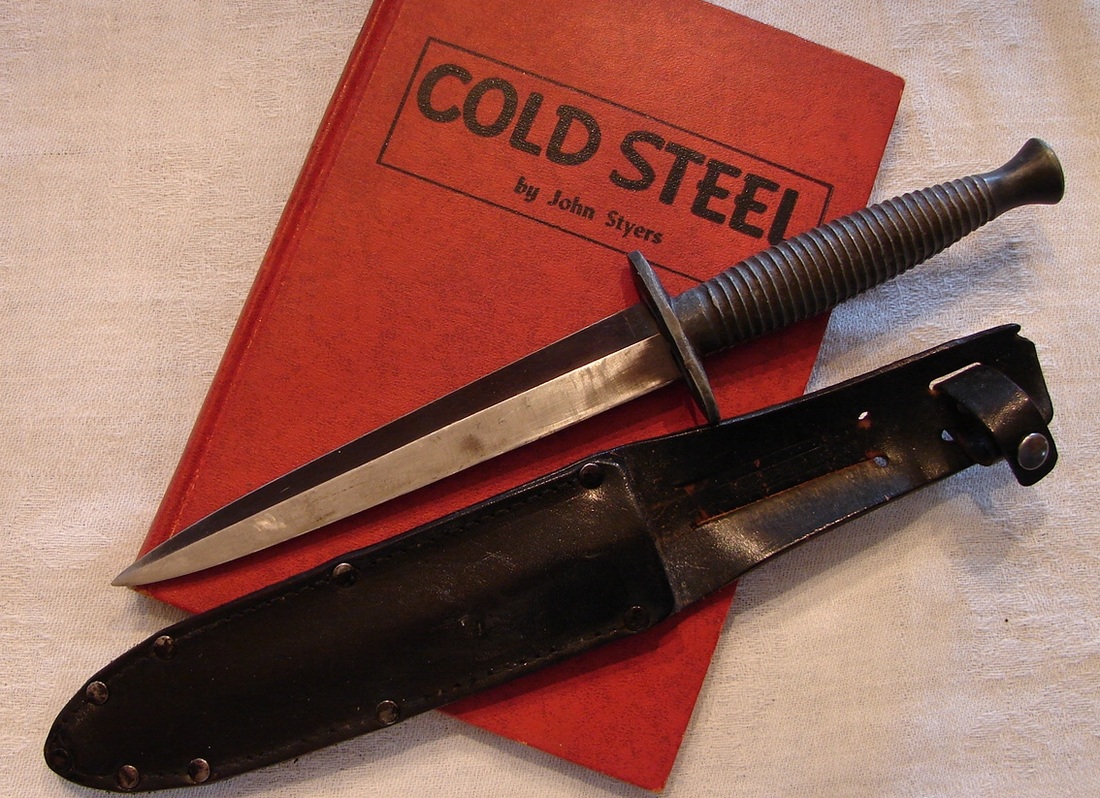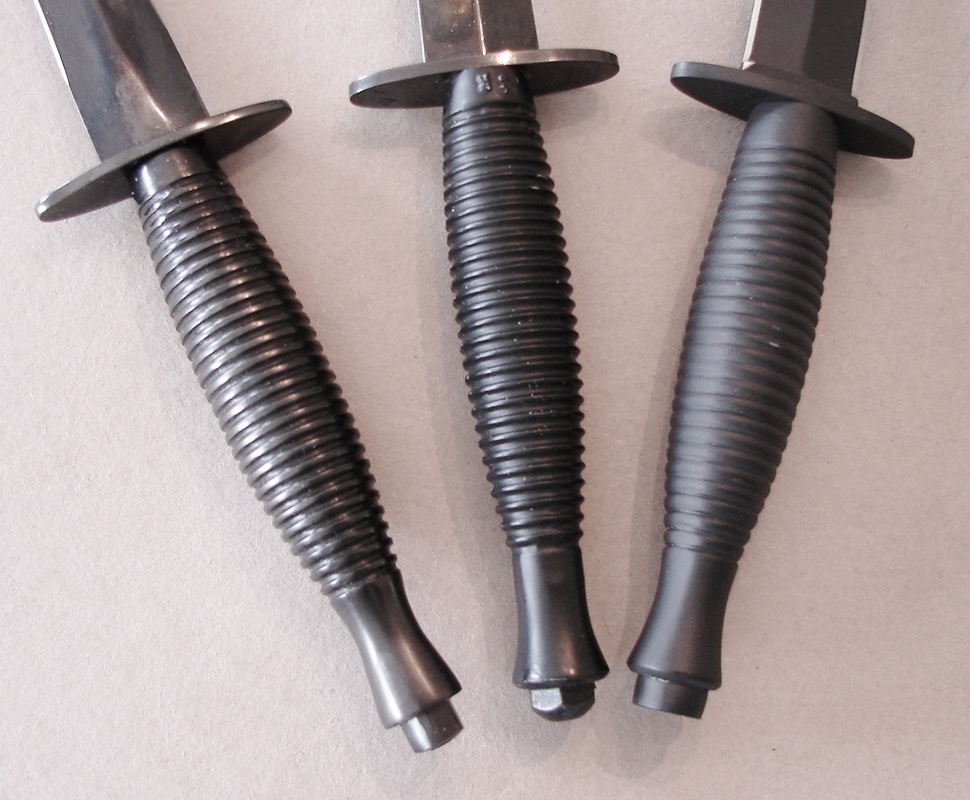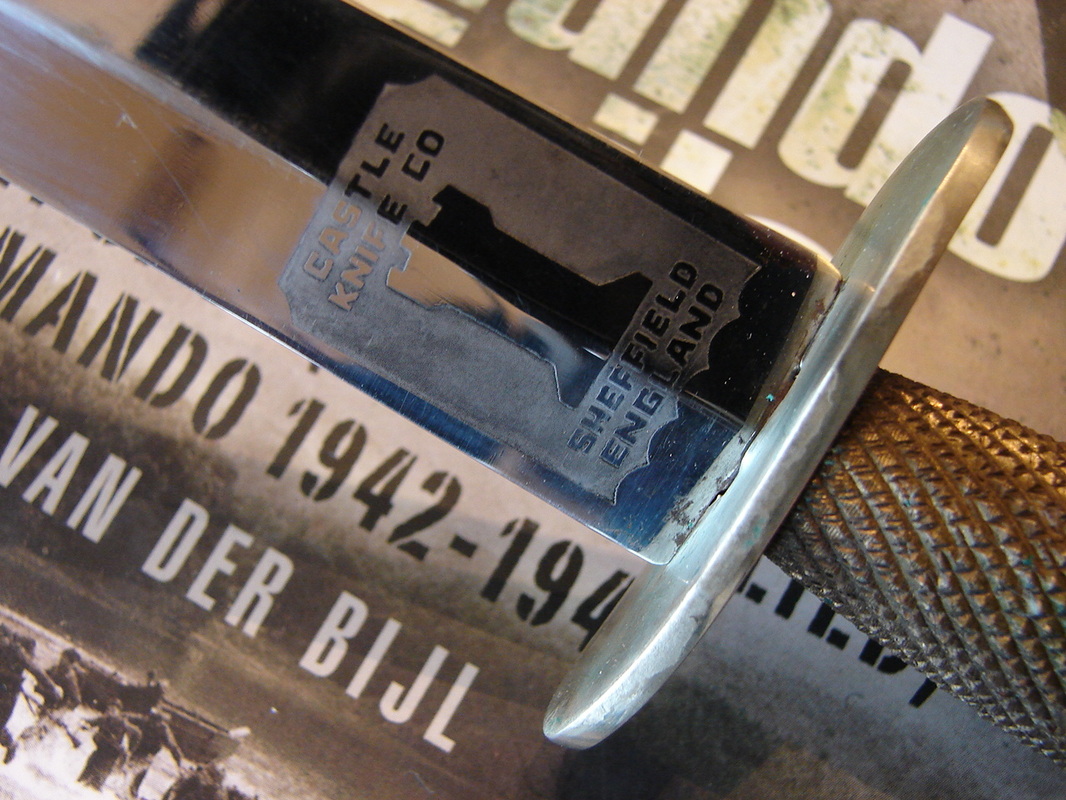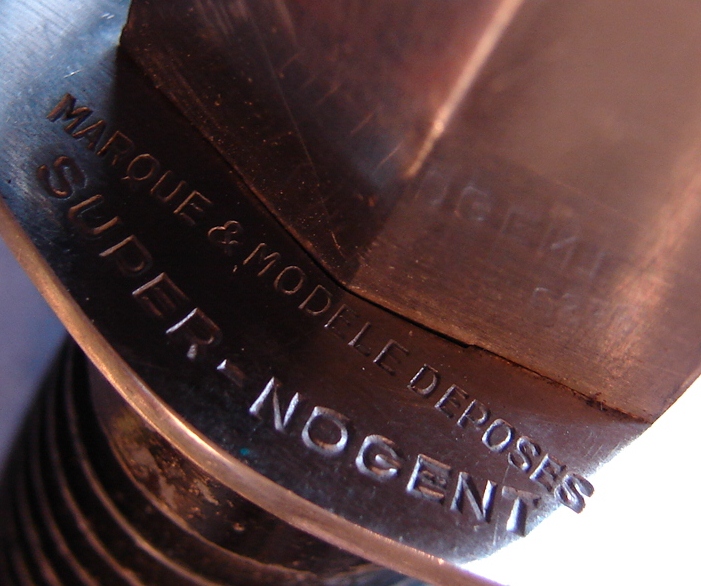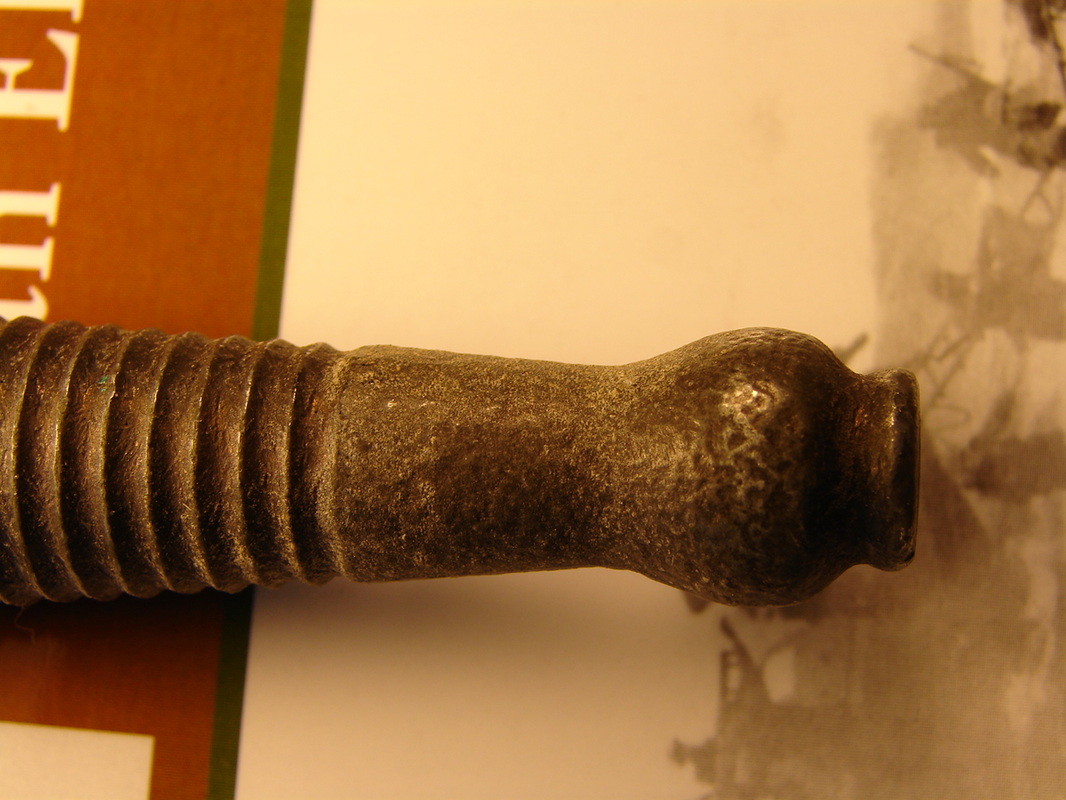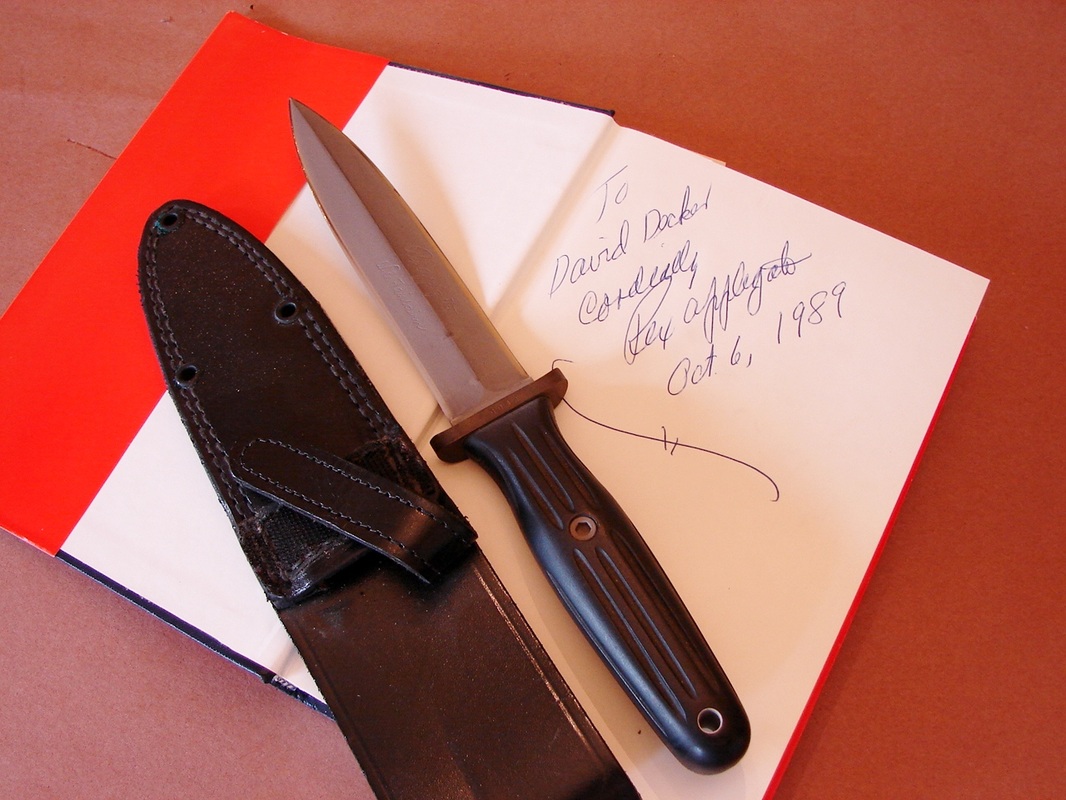Post WW-II Knives:
This page focuses on knives that are definitely post war and those we believe are. If you have any knowledge that places any of these knives being manufactured during the war please contact us.
This page focuses on knives that are definitely post war and those we believe are. If you have any knowledge that places any of these knives being manufactured during the war please contact us.
Below: Post war, 2002 model of the Cambodian Commando dagger. Decorative cast brass handle and guard. With what appears to be a typical mediocre quality blade. Genuine Cambodian commando knife used by the 2nd Battalion, 911 Special Forces Regiment. 28.4 cm dagger with 17 cm double-edged steel blade in good condition. Brass hilt is inscribed with the Cambodian word for COMMANDO, follow by "II" for 2nd Battalion, followed by "2001 2002" which corresponds to the year.
It turns out the knife is better quality than i expected. The blade has a patina of rust normally found on steels of lower grade that have not been well maintained. It has never been sharpened. The handle is cast or soldered in place and there is no top nut. That leaves one to wonder how long the tang might be. It is an interesting addition to my collection though and once again proves the variations on the F-S theme are nearly endless.
Below: We have two of these Vietnam era 5th Special Forces Group daggers. They were made by Japan Sword Company and are excellent quality. This one is in mint condition with the exception of the broken retention strap. The knives were reportedly issued at the tour's end. I have not done a lot of research on these so feel free to educate me on them.
Below: This is perhaps the prettiest Fairbairn style knife I ever bought for under $100. It was made in India and i bought it on ebay. The lovely shaped wood handle is brass wire wrapped and fitted with a recessed top nut like late model Wilkinsons. The blade is well ground and etched on one side with "Wilkinson Sword London" (I know it drives the purists nuts. They are highly offended that someone would copy the Wilkinson trademark but have no qualms about stealing my photos without my permission.) and "F S fighting knife" on the other side. The well formed and polished steel guard is tight with no wiggle or slop. The sheath quality is as good as any out of England today and it fits better than most of the British ones. For the price I am pretty stoked over this knife and I am glad to add it to my collection of other modern India-made F-S daggers. A nice bit of work from Krishna Handicrafts.
Below: NOW WE KNOW. The man who asked the question "who made it?" found his own answer. "Hello Dave.These knives were imported into Czechoslovakia 1972-80 from India. You're right. For what purpose I do not know." I asked how he found out and his answer was: "... told me that the owner of Veteran Bazaar Chotusice Mr. Paul Jerabek. When they were little kids play with these knives." It is nice to be right once in awhile!
Here are photos of a nice dagger submitted by a friend from Czechoslovakia. Perhaps one of you will recognize where it was made. My thoughts are Indonesia or India. It is very similar to those made in Cambodia. Looks like a nicely made knife. It incorporates a lot of styles: First Pattern blade and guard along with a handle similar to a Beaded and Ribbed. If you have any knowledge of the maker please contact us. we have more detailed photos as well from the owner. Thanks to him for sharing these images with us. The frog on the sheath looks like a later, but period, replacement.
Here are photos of a nice dagger submitted by a friend from Czechoslovakia. Perhaps one of you will recognize where it was made. My thoughts are Indonesia or India. It is very similar to those made in Cambodia. Looks like a nicely made knife. It incorporates a lot of styles: First Pattern blade and guard along with a handle similar to a Beaded and Ribbed. If you have any knowledge of the maker please contact us. we have more detailed photos as well from the owner. Thanks to him for sharing these images with us. The frog on the sheath looks like a later, but period, replacement.
Below: Another unusual variant to the F-S genre'. These were at one time issued to the special forces in Brunei. Made in Sheffield by Scorpion Knives. I had one heck of a time finding one. It bears the obvious cultural influence of an Indonesian Kris. I first learned about the existence of these from my good friend Leroy Thompson.

Below: Here are two knives made in the style of Special Forces daggers from the Vietnam era. There are no marks on the second one but the one just below is marked on the guard with the number 1042 and an embossed star. If you have any information on who the maker might be please contact me.
Here is a response i got from one of of our visitors from Indonesia. It is very rewarding when people take the time to research and share their findings with us and other visitors to this site. Thank you to Donny Winardi for providing this information.
I got a FS knife very similar with yours on this description. "Below: Another knife that seems to fit the pattern of Japan Sword Special Forces knife of the Vietnam era. Those were nickel plated but identical handles." very similar with yours, mine also got star stamp on the cross guard and number 6682 on it (the star got letter like PSM or PfM inside it) since I lived in Indonesia, it may be possible that the dagger is much older and brought here by British troops during 1945 - 1949 other possibilities is it was made for Indonesian Special Forces. The blade seemed to be very well made
will send you pictures if possible
I got similar knife and throw pictures of it to Indonesian forum and got a very interesting result
the knife is Indonesian made. the star stamp is the proof. the marking in the crossguard should be star and mine got 3 letters, PSM inside the star. Correct knife should also got serial number stamped on the crossguard. PSM stands for Pabrik Sendjata and Mesiu (Arms and Gunpowder Factory). This factory is indeed was made by Dutch and handed over to Indonesia in 1950. The factory changed its name (and supposedly marking) in 1958 when its name was changed to Pabrik Alat Peralatan Angkatan Darat (Army Equipment Factory)
this company PSM will evolve to become PT. PINDAD, now Indonesia's main arms manufacturer. www.pindad.com. FS knife is very well known here, as Kopassus knife (army special forces knife), but here lies a proof that it went back further than Kopassus era. Kopassus started in 1986 and this blade must've been made sometime around 1950 - 1958 and supposedly given to the predecessor of Kopassus, KKAD or RPKAD (Resimen Pasukan Komando Angkatan Darat) - Army Commando Regiment. my best guess is that PSM custom made it based on captured type 2 FS knife from British Troops during turmoil period in our Independence (1945 - 1949)
mine got iron handle, and apparently you got brass handle variant. Mine are solidly built and shows quality blade. a friend here remembered a veteran talking about this knife and its resilience and called it "tjap bintang" (star brand) and he said that this blade was only given to special person with high ranks, and not for everyone. He added that the knife is very rare now
this piece of history is new even to us. But I am satisfied I finally found the closure for the mystery blade
I got a FS knife very similar with yours on this description. "Below: Another knife that seems to fit the pattern of Japan Sword Special Forces knife of the Vietnam era. Those were nickel plated but identical handles." very similar with yours, mine also got star stamp on the cross guard and number 6682 on it (the star got letter like PSM or PfM inside it) since I lived in Indonesia, it may be possible that the dagger is much older and brought here by British troops during 1945 - 1949 other possibilities is it was made for Indonesian Special Forces. The blade seemed to be very well made
will send you pictures if possible
I got similar knife and throw pictures of it to Indonesian forum and got a very interesting result
the knife is Indonesian made. the star stamp is the proof. the marking in the crossguard should be star and mine got 3 letters, PSM inside the star. Correct knife should also got serial number stamped on the crossguard. PSM stands for Pabrik Sendjata and Mesiu (Arms and Gunpowder Factory). This factory is indeed was made by Dutch and handed over to Indonesia in 1950. The factory changed its name (and supposedly marking) in 1958 when its name was changed to Pabrik Alat Peralatan Angkatan Darat (Army Equipment Factory)
this company PSM will evolve to become PT. PINDAD, now Indonesia's main arms manufacturer. www.pindad.com. FS knife is very well known here, as Kopassus knife (army special forces knife), but here lies a proof that it went back further than Kopassus era. Kopassus started in 1986 and this blade must've been made sometime around 1950 - 1958 and supposedly given to the predecessor of Kopassus, KKAD or RPKAD (Resimen Pasukan Komando Angkatan Darat) - Army Commando Regiment. my best guess is that PSM custom made it based on captured type 2 FS knife from British Troops during turmoil period in our Independence (1945 - 1949)
mine got iron handle, and apparently you got brass handle variant. Mine are solidly built and shows quality blade. a friend here remembered a veteran talking about this knife and its resilience and called it "tjap bintang" (star brand) and he said that this blade was only given to special person with high ranks, and not for everyone. He added that the knife is very rare now
this piece of history is new even to us. But I am satisfied I finally found the closure for the mystery blade
Below: Recondo IV / KM 5000 from Eickhorn Solingen photos submitted by a visitor to our site
Below: Egginton Group's new Joseph Rodgers First Pattern knife. I have posted a complete review on my White Shadow Dojo blog site. It is a lovely knife and comes in a presentation box with a booklet that enhances the overall impression of the knife. It has one of the best F-S sheaths I have seen in many a year. There are some differences from the original WW-II First Pattern knives to be sure. But for those who cannot find or afford an original First Pattern it is a lovely option.
Below PPCLI: Two post war knives attributed to Princess Patricia's Canadian Light Infantry. The top one is the early 1950s style in a third pattern. The sheaths and knives were made separately and later mated up. The knives may be found from a variety of makers. The lower knife was purchased direct from the PPCLI stores in Canada and is of the unique "Besh Wedge" design, created by Canadian knife maker Brent Beshara. The Beshara knife is indestructible and comes in a modern plastic type sheath.
Below: When the "expert" gets fooled. I bought this knife from ebay . It was listed as an extra long french commando knife. So it is. It didn't take me too long to see why it was longer than usual. The blade has been lengthened by someone welding on an additional piece of blade. Whether this was done to repair a broken blade or because the owner wanted a longer knife is the question. The weld was very well done and a little more filing/grinding would have made the joint completely undetectable. The sheath was made specifically to accommodate this knife. As the old saying goes "caveat emptor."
Below: Shown below are a number of very fine French Commando knives from the era of the war in Indochina. The photos were provided by my good friend Fabrice Beaudot. I am very grateful for the use of these images of these high quality knives. We seldom have an opportunity to see such a variety of high quality French fighting knives.
A Spartan Blades - Les George Collaboration Dagger
Below: I have the solution for those of you who are tired of seeing "Made in China" on everything you buy. This dagger was designed and completely made in the USA by Americans of American sourced materials. Here is the newest collaborative dagger from Spartan Blades and Les George. The founders of Spartan Blades and Les are also military veterans. The blade is a bold undertaking with four hollow ground bevels and a center fuller! The knife has a 6 3/4 inch long, fullered, double-edged blade! It is made from 1/4 inch thick steel and has a beefy, but graceful, ricasso. I chose a ribbed green handle and black blade combination. An integral guard is well shaped and includes a thumb recess on each side to help the user orient the blade in the dark. This is one of the top daggers of the 21st century in my estimation. Les George also makes custom versions of this same knife. A very rugged and well-fitted sheath accompanies the knife. Your choice of colors, limited availability right now due to feverish demand. I suspect the crowd rush to buy them was a lot like the troops eager to buy one of Fairbairns first three hundred FS knives. http://spartanbladesusa.com/Fixed-Blades
Below: A selection of H.G. Long Post war knives including some examples of their high quality clandestine knives. H.G. Long was a major provider of clandestine knives during WW-II. Knife photo courtesy of a good friend in New Zealand.
Below: This is one of the three knives I took in trade. I really love the knife! This is reportedly one of the knives British Spec-Ops troops use. The Blackhawk logo and D-2 are etched on the blade. On the other side in small letters it is etched Taiwan. Made of full-tang construction this knife should be unbreakable under any normal usage and even extreme conditions. Unfortunately it also wins the award for the all-time worst sheath I have ever seen other than on the Puma Tac-1 knife. Come on Blackhawk, this knife deserves a lot better sheath! Shown with my trusty Kimber Stainless II .45 ACP.
The cross guard could have been a little less bulky, although I do like the forward sloping ramp for your thumb. The terrible sheath is shown below. Too often knife makers make sheaths only as an afterthought. They are an integral part of a system in my mind, like a katana and saya. I will probably never carry this knife but I may be forced to make or buy a new sheath just because this one is so terrible. The G-10 handle slabs are nice and "grippy."
Below: Here is another knife I took in trade. It is made in Germany by Carl Schlieper of Solingen. Blackened from top to bottom it is well built and tight. The handle screws on without a top nut to secure it. Very fine knurling marginally improves the grip. A traditional oval guard has rather large gaps between it and the blade on both sides. All in all typical of a modern knife. The blade is marked with the makers name on one side and a Tiger's head on the other. I believe the primary market for these is Indonesian military units. It is fitted in a fair quality sheath resembling the ones made in India or Pakistan. The strap has already broken through and the light weight chape needs regluing since there is no staple or rivet to affix it. Despite its shortcomings I have seen a lot worse copies in my life. I have one similar to this for sale on sales page. See The Updated information Below:
From a visitor to our site concerning the above knife:
Hi, first of all, thanks for your interesting site!
Some info about the German Schlieper FS in the section "Post War Versions": Yes, Schlieper produced quite a few FS for the Indonesian Special Forces (KOPASSUS) before their company went bankrupt in the 1990s. Not all of them were delivered to Indonesia, you can still find them on the market here in Germany. Those which never made it into export are usually sold in a generic FS sheath rather than in the Indonesian army sheath with official logo.
The version you are showing in the pics is not one of these made for the Indonesian military though - it was made for the Malaysian Special Forces (Grup Gerak Khas), including their tiger head logo: http://en.wikipedia.org/wiki/Grup_Gerak_Khas
ATM stands for "Angkatan Tentera Malaysia" = Malaysian Armed Forces. Indonesian export versions by Schlieper got the inscription "KOPASSUS" instead, showing their anchor logo instead of the tiger head, and instead of ATM they are marked TNI-AD (Tentara Nasional Indonesia - Angkatan Darat) = Indonesian Armed Forces - Army.
Hope that helps!
Best regards,
Jan B.
Hi, first of all, thanks for your interesting site!
Some info about the German Schlieper FS in the section "Post War Versions": Yes, Schlieper produced quite a few FS for the Indonesian Special Forces (KOPASSUS) before their company went bankrupt in the 1990s. Not all of them were delivered to Indonesia, you can still find them on the market here in Germany. Those which never made it into export are usually sold in a generic FS sheath rather than in the Indonesian army sheath with official logo.
The version you are showing in the pics is not one of these made for the Indonesian military though - it was made for the Malaysian Special Forces (Grup Gerak Khas), including their tiger head logo: http://en.wikipedia.org/wiki/Grup_Gerak_Khas
ATM stands for "Angkatan Tentera Malaysia" = Malaysian Armed Forces. Indonesian export versions by Schlieper got the inscription "KOPASSUS" instead, showing their anchor logo instead of the tiger head, and instead of ATM they are marked TNI-AD (Tentara Nasional Indonesia - Angkatan Darat) = Indonesian Armed Forces - Army.
Hope that helps!
Best regards,
Jan B.
Below: The seller of this knife believed it was Vietnam Era although it could be even newer than that. It has an unusual rebated ricasso and edges that are only sharpened part way up the blade. Mounted with brass pommel and guard along with small black and white spacers, it is a simple but elegant dagger. It has a nicely made leather sheath. The blade is lightly etched with the maker's name H.L. Morris of Farmington, MO. The Vietnam photos are mine, taken back "In the Day," in 1968. I think the handle is made from curly Ash. No its not a Fairbairn but what the heck its a really nice dagger all the same.
Below: This photo illustrates four smaller post-war knives in the Fairbairn-Sykes style. Note the unmistakable similarity of the roughly six inch long blades. As far as I can tell, three of the knives were marketed by different firms. The one on the far right is double stamped INOX which leads me to believe it is a French knife, or made for sales in France. One of the knives came with an owner-added leather cover on the handle with a small brass D-ring. This might indicate it was used in a maritime environment where a lanyard can be attached to prevent loss. Third knife from the left has a leather washer handle and skill crusher pommel like found on the famous V-42 stiletto. It looks like all of the blades were likely produced in Sheffield, England by the same company.
|
Here we have photos of a post-war knife provided by a British Royal Marine. He noticed the one I have posted under blade etchings and which I attributed to possibly J. Nowill & Sons. Clearly this one was marketed by Woodhead of Sheffield. I have several knives in my collection that have similar blades (see above) but are marked by different makers. None of them bear this royal crest. By the way, Woodhead was the maker of some terrific Bowie knives during the American Gold Rush era.
Hi David, I am quite happy for you to use the photos on your website. I was in the Royal Marines from 1958 to 1966 and served with 40 Commando in various parts of the world from Malta in the Near East to Malaya and Borneo in the Far East. I don't know the history of this knife. my wife. She served with the Women's Royal Navy Service(WRNS) and were known as Wrens. At the end of her basic training she then served with the Royal Marines. Wrens who served with the Corps were known as Marens. They were very proud of serving with elite and as they say 'Once a Maren, always a Maren'. |
Hill Dagger Below: Along with the Eickhorn dagger, this is among the very best of the modern F~S I have yet seen. I could not decide whether to place it here, or in the custom section. It is a semi-custom knife, 250 copies being produced in all. The handle is a lathe turned aluminum with a very nice coating. The blade, like the Eickhorn, has a ricasso similar to a first pattern to strengthen the blade at the guard juncture. Numbered 249/250, this fine fighting knife was a gift from a visitor to our website. He refused to accept any compensation and donated it in consideration of time I spent discussing knives with him. Acts of such generosity are extremely rare in today's world and I am very grateful for this excellent addition to our "Virtual Museum" on Fairbairn Sykes Fighting knives. The sheath is a unique blend of a hard plastic body with nylon webbing hanger. Retention is assured by a strong elastic cord with a pull tab. Altogether a super knife.
Egginton Group Knife:
Fresh from England, the latest addition to this website is the Egginton Group's version of the FS issued by the MOD (Ministry of Defense) to troops going in harms way. The nicely blued blade is 6 7/8 inches long. I was surprised to find that the blade is thicker than one of my heavy forged WW-II knives. The machine ground finish is much finer than many post-war knives and is produced by a combination of machine and hand finishing. The grinds are completely symmetrical and centered. The handle is a well formed, clean casting. Typical of most modern F-S it is a little shorter than WW-II knives and the ribs are rounded over. The traditional guard is well shaped of the thinner gauge common today. (Again the manufacturer explained this is specified by the MOD) This one is completely sterile with no markings at all. The opening for the guard is a closer fit than on many contemporary knives and the guard is tight without any wiggle. My overall impression is of a well built and sturdy fighting knife. There is a reassuring heft to it that Fairbairn said would inspire confidence in the trooper carrying one.
Fresh from England, the latest addition to this website is the Egginton Group's version of the FS issued by the MOD (Ministry of Defense) to troops going in harms way. The nicely blued blade is 6 7/8 inches long. I was surprised to find that the blade is thicker than one of my heavy forged WW-II knives. The machine ground finish is much finer than many post-war knives and is produced by a combination of machine and hand finishing. The grinds are completely symmetrical and centered. The handle is a well formed, clean casting. Typical of most modern F-S it is a little shorter than WW-II knives and the ribs are rounded over. The traditional guard is well shaped of the thinner gauge common today. (Again the manufacturer explained this is specified by the MOD) This one is completely sterile with no markings at all. The opening for the guard is a closer fit than on many contemporary knives and the guard is tight without any wiggle. My overall impression is of a well built and sturdy fighting knife. There is a reassuring heft to it that Fairbairn said would inspire confidence in the trooper carrying one.
Eickhorn:
This is one of the finest post-war commando knives I have ever seen! It is based upon the Third Pattern but has a blade shaped similar to a Gerber MK-II. The blade is razor sharp and finely finished. On one side it is numbered "102 of 999" and Eickhorn's trade mark. On the opposite side the blade is marked with the WW-II Combined Operations logo. The thick steel guard is perfectly fitted and also well finished. I believe the handle is turned from aluminum and has a larger swell at the pommel than usually seen on P-3s. The swell allows a large recessed top nut to be installed to pull the knife together. The balance point is right at the guard. This is the highest quality knife and sheath combo of any modern F~S style knife I have seen. Impressive!
This is one of the finest post-war commando knives I have ever seen! It is based upon the Third Pattern but has a blade shaped similar to a Gerber MK-II. The blade is razor sharp and finely finished. On one side it is numbered "102 of 999" and Eickhorn's trade mark. On the opposite side the blade is marked with the WW-II Combined Operations logo. The thick steel guard is perfectly fitted and also well finished. I believe the handle is turned from aluminum and has a larger swell at the pommel than usually seen on P-3s. The swell allows a large recessed top nut to be installed to pull the knife together. The balance point is right at the guard. This is the highest quality knife and sheath combo of any modern F~S style knife I have seen. Impressive!
Reginald Cooper:
Here is an example of a third pattern knife that typifies the slacking of quality in fit and finish, POST-WAR. Believe it or not, this knife is better than many others I have seen. Note the mold parting mark that interrupts the handle rings and the crudely sheared cross guard with its rough edges. The top nut shows the grinding marks where the tang was simply ground off and not peened over. There are large gaps between the blade and where it passes through the guard. These gaps can allow moisture and crud to get inside the handle leading to corrosion. On a positive note, the blade is not badly ground or finished and the sheath is much better than most.
Here is an example of a third pattern knife that typifies the slacking of quality in fit and finish, POST-WAR. Believe it or not, this knife is better than many others I have seen. Note the mold parting mark that interrupts the handle rings and the crudely sheared cross guard with its rough edges. The top nut shows the grinding marks where the tang was simply ground off and not peened over. There are large gaps between the blade and where it passes through the guard. These gaps can allow moisture and crud to get inside the handle leading to corrosion. On a positive note, the blade is not badly ground or finished and the sheath is much better than most.
|
Pakistani P-3:
At some point in the 1960s Pakistani craftsmen built F~S knives that were probably of equal quality to some of the cheaper contemporary British knives. I picked up two of these knives over the years. They were reportedly made during the Vietnam War era and were available commercially. These Pakistani models are very similar to a British P-3, although the rings tend to be a bit narrower. The handles on the two I have are nicely lathe-turned, one from aluminum the other from brass. The guards are the same thickness and shape as a British war-time knife. The seven inch blades are ground with accurate and symmetrical bevels and the whole lot is held together with a semi-traditional top nut. The image here shows one of the knives from our collection transposed on a page of Michael Silvey’s superb book entitled "Knives of the United States Military-World War II.
Unknown P-1:
I have no information about the following knife. It is a very well built First Pattern, presumably post-war, and perhaps a product of H.G. Long. I am basing that guess on the logo and general proportions. In my forthcoming book I will finally reveal who really made these knives. The logo is a little clumsy, too narrow, and too deeply etched, which is often the case with post-war knives and those made in third world countries.
Indian or Spanish P-3:
The following knife is typical of a post-war F~S copy made in India back in the 1950s or 60s. The quality is terrible with a soft, untempered blade with a good deal of rust staining. The rust came from the equally poor quality sheath and improper tanning of the leather. I bought this knife primarily for an example of what was being produced in 3rd world nations to capitalize on the popularity of the Commando Knife. I have seen some identical knives attributed to Spain. Egypt maybe? They're all junk. This close-up shows the details of the very thin guard, lathe turned brass handle and the tiny, unusual top nut. You can gauge how thin the tang is by how small the top nut is!
Mass Produced Copies:
J. Nowill & Sons, H.G. Long, Windlass Steelcraft, etc: One of the few current manufacturers that offers a high quality F~S knife is J. Nowill and Sons. A search of the internet, Ebay, or Amazon will net you a Nowill P-3 style knife for anywhere from $90 to $170 so it definitely pays to shop around. I would rate the Wm. Rodgers F~S knives almost the same quality as the Nowill knives. A few years ago H.G. Long produced very high quality P-1s and P-2s and marketed them through various cutlery shops. Their knives are definitely worth buying should you find one. And of course there are the Wilkinson reproductions that are of very high quality although they are often not intended for combat use, being mostly issued as gilded commemoratives. Illustrated below is a very neat, extremely well made, J. Nowill & Sons third pattern commando knife. The sheath is another story. More of the Nowill knife Below: Close-up of the Nowill and Sons guard stamping. Their handles have a raised "crossed keys and asterisk" logo. The fit and finish of the Nowill knives is quite good and the blades are nicely polished and blued.
Unknown Manufacturer:
Illustrated below is a nice little post-war, German made, F~S knife. It is about a 7/8ths in size. The handle and guard are cast as one piece, in place. It does not have a top nut holding it together. It is a fairly well made knife typical of countless reproductions made by Germany or Japan in the 60s. My notes indicate I paid $15 for this knife and sheath, giving you an idea of how un-collectible they are. Many similar knives are available today, but of poorer quality, from China, Pakistan, Taiwan, etc. The book, "Cold Steel" is a good read and actually more valuable than the knife lying on it! Another good book is William Cassidy's "Complete Book Of Knife Fighting." They are much more comprehensive than Fairbairn's "Get Tough."
Illustrated above (and below) are three fairly common third pattern knives manufactured today. They are, from bottom to top: Windlass Steel, J. Nowill & Sons, and Linder. Of the three the Windlass Steel best replicates the WW-II knives, with the exception of its goofy top nut.
NOTE: At the end of February I heard from another buyer who was totally satisfied with his Windlass knife so maybe it was simply a batch of less carefully made knives and things are back to normal. Above: Left to Right: Windlass Steel, J. Nowill & Sons, and Linder knives.
A. Wright P-2:
This is likely a post war knife and the only one of its kind I have come across. It is quite well made. The turned and knurled brass handle is smaller in diameter that a standard P-2 and lacks the bowling pin shape. The crossguard is stamped, A. Wright Sheffield England." The blade has a faint "SAS" marking and is nicely formed and polished. The sheath this knife came in is without its frog (below) but appears to be of wartime, or early manufacture. The previous owner added a thong to tie in the knife although how he actually carried it is not known, maybe stuffed in the top of his boot.
Applegate Fairbairn:
There are many Applegate~Fairbairn copies on the market. The earliest models were made by TJ Yancy. The one I own was made by Bill Harsey and purchased personally from Col Rex Applegate along with this autographed copy of his book "Kill or Be Killed." Copies of the A~F were produced by Al Mar, Blackjack Knives, and eventually Boker Knives. Some material or molding problem has caused almost all of the Blackjack versions to develop a non-critical crack near the butt end of the handles. The custom knives have lead weights inside the handle that can be moved, or removed, by unscrewing the handles, thereby adjusting the balance to the owner's taste. The Harsey model is one of the sharpest stainless steel knives that I own. But, is the A~F a vast improvement over the original F~S? I suppose that depends on what you want in a knife. It will definitely cut better than a traditional F~S because of the flatter bevels, due to a wider blade. The oval shaped handle accurately positions the knife in your hand and the groves provide very good weapon retention. Penetration with the shorter A~F is more than adequate. But in my opinion it still lacks that classic elegance and presence of a P-1 or even a P-2 Fairbairn~Sykes. I personally think it would have been an even better knife with a 7 inch blade, but longer blades were going out of fashion when this knife was designed. The rugged leather sheath that came with the knife was a major improvement over the fragile F~S sheaths, although the velcro on the retention strap ruined any chance of drawing the knife silently. Would WE Fairbairn approved? Probably, since this knife incorporates many of the things he expected in a fighting knife and eliminated some of those things about the Wilkinson F~S which he objected to.
|
Hanwei Forge: The knife illustrated below gives you an idea of the quality that Chinese cutlers can produce when they are inspired (paid) to do so. It is a beautifully forged and ground Damascus First Pattern F~S. This one is number 209 of 1000. It came in a fitted wooden case, a quality leather sheath, and a Damascus belt buckle with the letters F-S inlaid in gold. The guard is delicately engraved and the pommel is also Damascus.
Castle Knife Co.:
I first saw an advertisement for them in the pages of “Soldier of Fortune” magazine. Yes at the time I fancied I might like to pursue the life of a mercenary. To my eternal benefit my wife did not share that same enthusiasm. So to assuage my stunted dreams of life in the Congo or Rhodesia I ordered a copy of Wm. Cassidy’s lovely Fairbairn- Sykes knife. It cost all of seventy five dollars plus shipping. I mailed off a check and before too long it arrived in a shipping tube with some paperwork. If I had been more visionary I would have found the means to order a dozen of them. The top knife is a sterile version, the bottom one has the famed W.E. Fairbairn signature and the F~S and Castle logos. Rather than infringe on Mr. Cassidy’s copyrighted story I will provide you with a link so that you may read his interesting story in full. http://blackjack.0catch.com/pages/cassidy.htm
Mr. Cassidy’s knife is a sweet amalgamation of several designs which results in a very unique but functional and highly attractive knife. For example: it’s handle is reminiscent of the O.S.S. Stiletto, having the same coarse knurling which runs all the way to the guard. The guard itself is nickel plated and “S” curved, very much like those on a P-1. The blade is comparable to a thin bladed P-2 or P-3 and delivered sharp. Unlike the late war P-3s the blade is well finished with a near-mirror polish. The blades were then etched with Wm. Fairbairn’s signature and also exhibit the traditional F~S logo near the guard. In profile, the blades resemble the O.S.S. stiletto. In the years since, I have picked up a couple more of these, including the sterile ones which sold for eighty dollars. You can rest assured that I did not buy them for that cheap price at this later date. The knives came fitted with a commercial style sheath which was well made of fine leather. Should you have the fortune to come across one it is a viable fighting knife with a nice story to tell. I'd recommend you buy it. My personal thanks to Mr. Cassidy and the British workmen who were for a short period of time, The Castle Knife Co. for producing these fine knives.
Below: One of the best Post-war FS knives is the French version issued to French Paratroopers and members of the Foreign Legion. It has an alloy handle very similar to a third pattern. The stainless steel blade is broader and well finished. The "Inox" stands for inoxidizable, ie non-rusting steel. The high quality sheath is very unique in that it has a belt-boot clip on the back. This knife was still being produced recently and the one in the photo served in Vietnam, carried by a French soldier.
Below: Here is another Post-war French F~S with an unusual black fiber and brass washer handle. It has a small stainless "S" guard. The blade is stainless and quite narrow. It is a nicely made knife and well balanced, coming in an unusual leather sheath that may not be original to it.
The following knife is unlike any other I have seen. It is of acceptable quality with an alloy handle either cast onto the tang, or perhaps driven on. There is no top nut, it is part of the casting. The guard and blade are standard late P-3 style and the blade gives indications of having been blackened at one time. It is in this section because it has the appearance of being a post-war knife although I cannot confirm that. I have learned it was produced by a company named Crown Sword. Note the price of $1 on the vintage copy of "Get Tough."
Below: The next knife is produced by Linder, and while well made is less polished than the Nowill and its blade is thinner, it is still a credible fighting knife. The Linder knife has a very small ricasso which is unusual among third pattern knives. During my penetration tests the Linder finished in second place which is quite impressive. Of course this was party due to the thinness of the blade. I will post better photos later.
Note in the close-up below the small ricasso on the Linder blade and the somewhat poor fit between the blade and guard.
Below: The following pair of third pattern knives are from Germany from a manufacturer named WKC, Weyersberg, Kirschbaum, & Cie. They have "S" guards similar to the First Pattern style knives.
About equal in quality to the late production Wilkinsons, these knives were delivered completely un-sharpened (to meet export compliance?). The nickle plated one even came with a bit of a rust spot on the blade and the blued blade had some scuffing as well. Perhaps they were shopworn or display versions? While they make a nice addition to the collection I would probably buy one from Windlass (at 1/2 the price) and not worry about scratching up the blade by using it and at least it came somewhat sharp. Second choice woulld be difficult, picking either the Linder or the Nowill.
In the photo below you can see the makers tag. The knives did not come with sheaths and they were available either chrome plated or gold plated as shown.
In November 2005, WKC purchased the tooling from Wilkinson Sword Ltd. for production of various ceremonial swords, including the F+S Knife. Now we know why it looks like a Wilkinson : ) Wasp Dagger: These photos were provided by a visitor to our site. they represent a form commonly called a "Wasp" dagger. So named according to the style of the handle which is built up with composite washers alternating with brass ones. Many different versions are available with leather and stag antler handles. The blades are stamped with different makers names but appear to have been produced by the same maker. They are often hyped as paratrooper or airborne models but there is no basis for this.
|
Below: A custom Bill Harsey crafted Applegate~Fairbairn along with an autographed copy of "Kill or Get Killed" signed by the legendary Rex Applegate himself. Colonel Applegate was a gentleman and extraordinary instructor of hand to hand combat, an eager student of WE Fairbairn and quick to pass on his knowledge to others in the O.S.S.. It was my pleasure to talk with him on the phone and by letter. I regret never having an opportunity to meet him in person. At the time I bought this Harsey knife the Colonel also sold Al Mar versions. I asked him which he recommended. He referred to the Al Mar version as the "Christmas Tree" model because of its glitter and flare. I bought the plainer, more expensive, Harsey knife.
Below: Perhaps one of the finest Post-War second pattern knives (other than Wilkinson) is this fine example made by H.G. Long & Co.. Established in 1846 they have also created other fine reproductions like the V-42. H.G. Long has also made some fine reproduction First Pattern Knives and SOE style covert knives.
Below: Another excellent example of a Second Pattern knife, which I presume to be Post-War. It is made by a little known company named Imperial Gudedge. The main difference between this knife and a WW-II Issue is this knife's blade is thinner than the WW-II versions.












